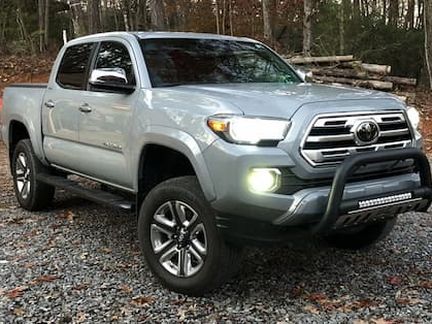Recovery Straps vs. Tow Straps
Updated on Apr 15, 2024
When sourcing a set of straps for your vehicle, you'll likely come across two options–tow straps and recovery straps. While both products are similar, they aren't interchangeable.
Recovery straps and tow straps are manufactured using different materials for different purposes; haphazardly mixing up the two can lead to vehicle damage, broken straps, and even injury! Read on to learn more about these two products and their specific uses.
Recovery Straps
Recovery or "snatch" straps are engineered for recovery situations, such as freeing a pickup submerged in mud or a Jeep high-centered on the trail. Recovery situations typically occur when a vehicle is impossibly stuck, requiring more force than a slow, controlled tug with a tow strap. This is why recovery straps are manufactured from flexible nylon, unlike rigid polyester tow straps.
Due to the elasticity of the recovery strap, the tow vehicle can get a running start when attempting an extraction. The resulting kinetic energy generated from the strap rapidly stretching and contracting provides a secondary "pull," giving the recovery a better chance at success.
Recovery straps also feature nylon-loop ends instead of the classic cast-metal hooks that finish off tow straps; this is done for several reasons. Firstly, nylon loops aren't likely to break when subjected to extreme forces–i.e., getting a running start on an extraction. Secondly, the soft nylon loop ends are far less abrasive to body panels, bumpers, and other painted, polished, or powder-coated surfaces.
Tow Straps
As their name suggests, tow straps are engineered for towing vehicles rather than assisting in recovery situations. Tow straps are typically manufactured from tight-knit polyester, providing practically zero flex or stretch. Additionally, tow straps feature integrated metal hooks that, while sufficient for low-speed towing, may slip or shear when subjected to the extreme forces of a recovery situation.
Unlike recovery straps, whose characteristic elasticity and nylon loop ends make them somewhat forgiving, tow straps are stiff and must be taken seriously. Especially when coupled with the integrated metal hooks, tow straps must be used as directed so as not to cause injury.
When setting up a tow strap, you must remove all the slack before the actual towing can commence. While towing, it's essential to apply slow, constant tension to avoid uncomfortable and dangerous snaps between slack and tension. However, when used as designed, tow straps are a useful tool that should be included in every truck or Jeep owner's arsenal!
What Are the Primary Differences?
Though we touched on a few distinctions in the previous section, we'll now flesh out all of the essential differences between recovery and tow straps.
Material Construction
One of the most notable differences between recovery and tow straps is their material construction. Recovery straps are manufactured from high-strength nylon, while tow straps are typically produced from polyester. While both fabrics are incredibly durable, they have different properties that should be considered when selecting which strap to use for the task at hand.
Design
Tow straps are typically sewn into loops at the ends, affixing a non-removable cast alloy hook. By comparison, recovery straps use no metallic elements in their design; instead, they rely on larger nylon loop ends designed to secure a D-ring or soft shackle.
Elasticity
This characteristic is the most significant differentiating factor between these two styles of straps. Recovery straps are incredibly flexible, absorbing some of the impacts of a recovery procedure and providing an additional "tug" due to kinetic energy. Tow straps, however, are incredibly stiff with little to no give.
Price
Due to tow straps' simple design, they're typically less expensive than recovery straps. However, if you feel like shelling out the extra funds for a recovery strap, they'll likely pay for themselves with the money you'll save on tow truck bills.
How to Choose the Right Strap
Do you still need help deciding which style strap is right for you? Let's take a look at some key factors to consider.
How is Your Truck Used?
Depending on the general usage of your pickup, one strap may better suit your needs than the other. A recovery strap is a worthwhile investment if you regularly wheel your pickup or travel through extreme terrain. However, if your truck primarily sees street driving, a standard tow strap will typically suffice for the occasional tug.
Your Vehicle's Weight
Though recovery straps typically have a higher breakage limit, weight is an aspect to consider no matter which style of strap you're looking to purchase. As a rule of thumb, find a strap with a tow rating of approximately 3x your pickup's weight–this accounts for your pickup's weight and the forces applied during an extraction.
Recovery Points
What type of recovery points does your pickup have? If you're stuck with factory-style tow hooks, a standard tow strap will better suit your setup. However, if your truck is running heavy-duty bumpers with built-in D-Ring shackles, then the loop ends of a recovery strap are better suited.
Both recovery and tow straps are an excellent addition to your pickup's arsenal. From helping yourself out of a sticky situation to giving a helping hand to a stranger in need, straps are a worthwhile purchase.
And if both fit into your budget, carrying an assortment of straps is never a bad idea to be prepared for any possible recovery situation! For more information, check out our wide selection of straps.
Shop Now
RealTruck is your home for the best products to outfit your build for unforgettable adventures.
See Recent RealSource Articles Here...
- …
Join over 2 million RealTruck people
Get exclusive savings, insider information, and the latest RealTruck articles sent straight to your inbox.



